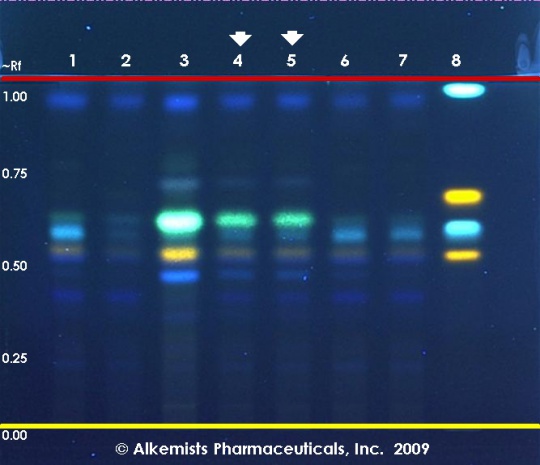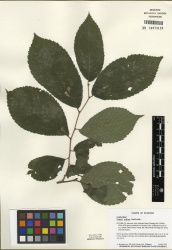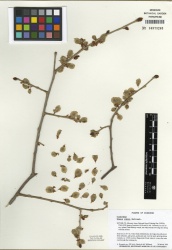|
AHPA recognizes other valuable resources exist regarding the identity of Ulmus rubra.
To submit a suggestion or contribution, please contact Merle Zimmermann.
|
Nomenclature
Ulmus rubra Muhl. Ulmaceae
Syn. Ulmus fulva Michx.
Standardized common name (English): slippery elm
Botanical Voucher Specimen
Organoleptic Characteristics
[Ulmus rubra (bark)] odor distinct; taste mucilaginous.
Source: United States Dispensatory (1918) [3]
|
|
|
|
|
Macroscopic Characteristics
| The slippery elm (Ulmus fulva), is a lofty tree, fifty or sixty feet in height, with a trunk fifteen or twenty inches in diameter. The bark of the trunk is brown, that of the branches rough and whitish. The leaves are petiolate, oblong-ovate, acuminate, nearly equal at the base, unequally serrate, pubescent, and very rough on both sides. The buds, a fortnight before their development, are covered with a dense russet down. The flowers, which are apetalous, appear before the leaves, are sessile, and in clusters at the extremities of the young shoots. The clusters of flowers are surrounded by scales, which are downy like the buds. The calyx is also downy. The stamens are five, short, and of a pale rose color. The fruit is a membranaceous capsule or samara, enclosing in the middle one round seed, destitute of fringe. outer surface of a light brown or buff color with occasional dark brown patches of adhering cork, longitudinally striate and with detachable bundles of bast-fibers, and colored blackish upon the addition of a very diluted iodine T.S.; inner surface light yellowish-brown, nearly smooth and finely striate, only slightly darkened upon the addition of a very diluted iodine T.S.; fracture fibrous with projecting bast-fibers, the broken surface porous, due to the large mucilage cells. [...] The powder is very light brown.
Source: United States Dispensatory (1918) [4]
|
|
|
|
|
Microscopic Characteristics
| Under the microscope [Ulmus rubra (bark) powder] shows mostly fibrous fragments, and a finely granular portion made up of small starch grains, the latter being immediately colored bluish-black upon the addition of iodine T.S.; starch grains mostly spherical or more or less polygonal, usually about 0.003 mm. in diameter, but also attaining a diameter of 0.025 mm.; bast-fibers very long, about 0.02 mm. in diameter, with rather thin, slightly lignified walls; calcium oxalate in monoclinic prisms, mostly in crystal fibers, the individual crystals from 0.01 to 0.025 mm. in diameter; fragments of large mucilage cells with adhering starch grains. Macerate 1 Gm. of powdered Elm with 40 mils of distilled water for an hour and forcibly strain; the solution is of a mucilaginous consistence.
Source: United States Dispensatory (1918) [5]
|
|
|
|
|
High Performance Thin Layer Chromatographic Identification

Ulmus rubra HPTLC ID - Natural Product Reagent + PEG-> UV 365 nm
Slippery Elm (bark) (Ulmus rubra)
Lane Assignments Lanes, from left to right (Track, Volume, Sample):
- 3 μL Ulmus rubra-1 (bark)
- 3 μL Ulmus rubra-2 (bark)
- 3 μL Ulmus rubra-3 (bark)
- 3 μL Ulmus rubra-4 (bark)
- 3 μL Ulmus rubra-4 (bark)
- 3 μL Ulmus rubra-5 (bark)
- 3 μL Ulmus rubra-6 (bark)
- 1 μL Rutin, Caffeic acid, Hyperoside, Chlorogenic Acid ~0.1% in CH3OH
Reference materials used here have been authenticated by macroscopic, microscopic &/or TLC studies according to the reference source cited below held at Alkemists Laboratories, Costa Mesa, CA.
Stationary Phase Silica gel 60, F254, 10 x 10 cm HPTLC plates
Mobile Phase ethyl acetate: glacial acetic acid: formic acid: water [10/1.1/1.1/2.4]
Sample Preparation Method 0.3 g + 3 ml CH3OH sonicate/heat @ 50° C ~ 1 hr.
Detection Method Natural Product Reagent + PEG-> UV 365 nm
Reference see British Herbal Pharmacopoeia, 1996
Source: Elan M. Sudberg, Alkemist Laboratories [6]
|
Supplementary Information
Sources
- ↑ MOBOT, Tropicos.org http://www.tropicos.org/Image/100123357
- ↑ MOBOT, Tropicos.org http://www.tropicos.org/Image/100123358
- ↑ United States Dispensatory (1918)
- ↑ United States Dispensatory (1918)
- ↑ United States Dispensatory (1918)
- ↑ Elan M. Sudberg, Alkemist Laboratories http://www.alkemist.com



